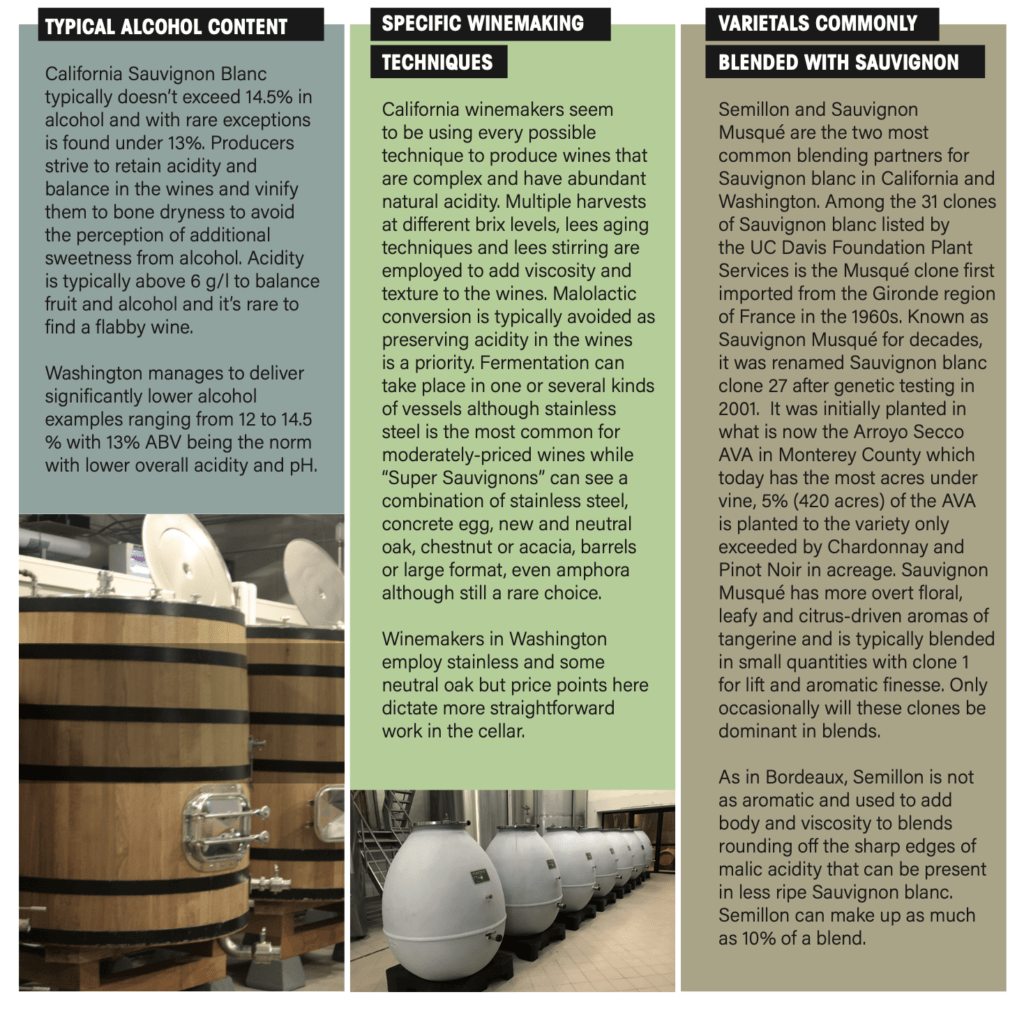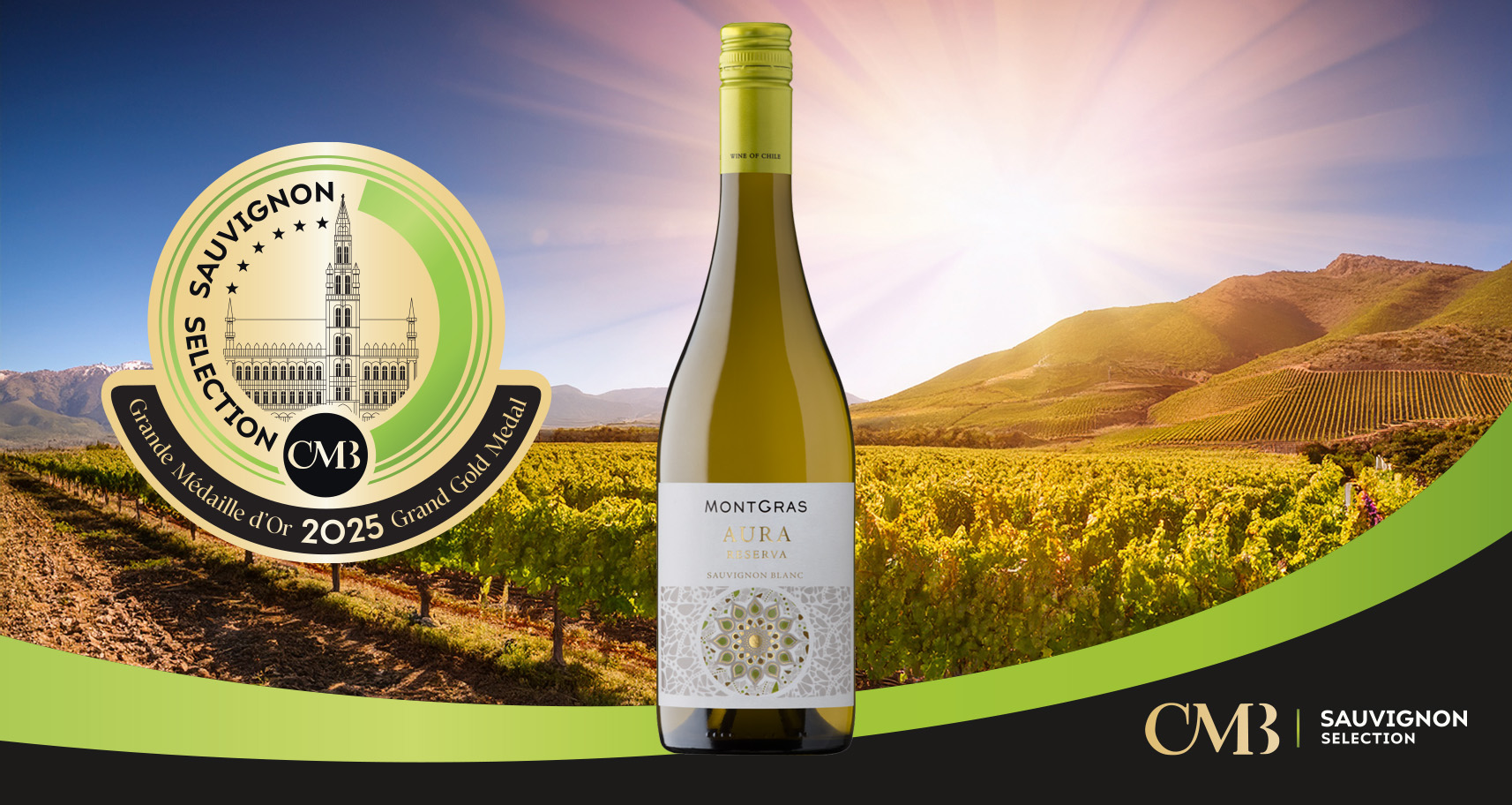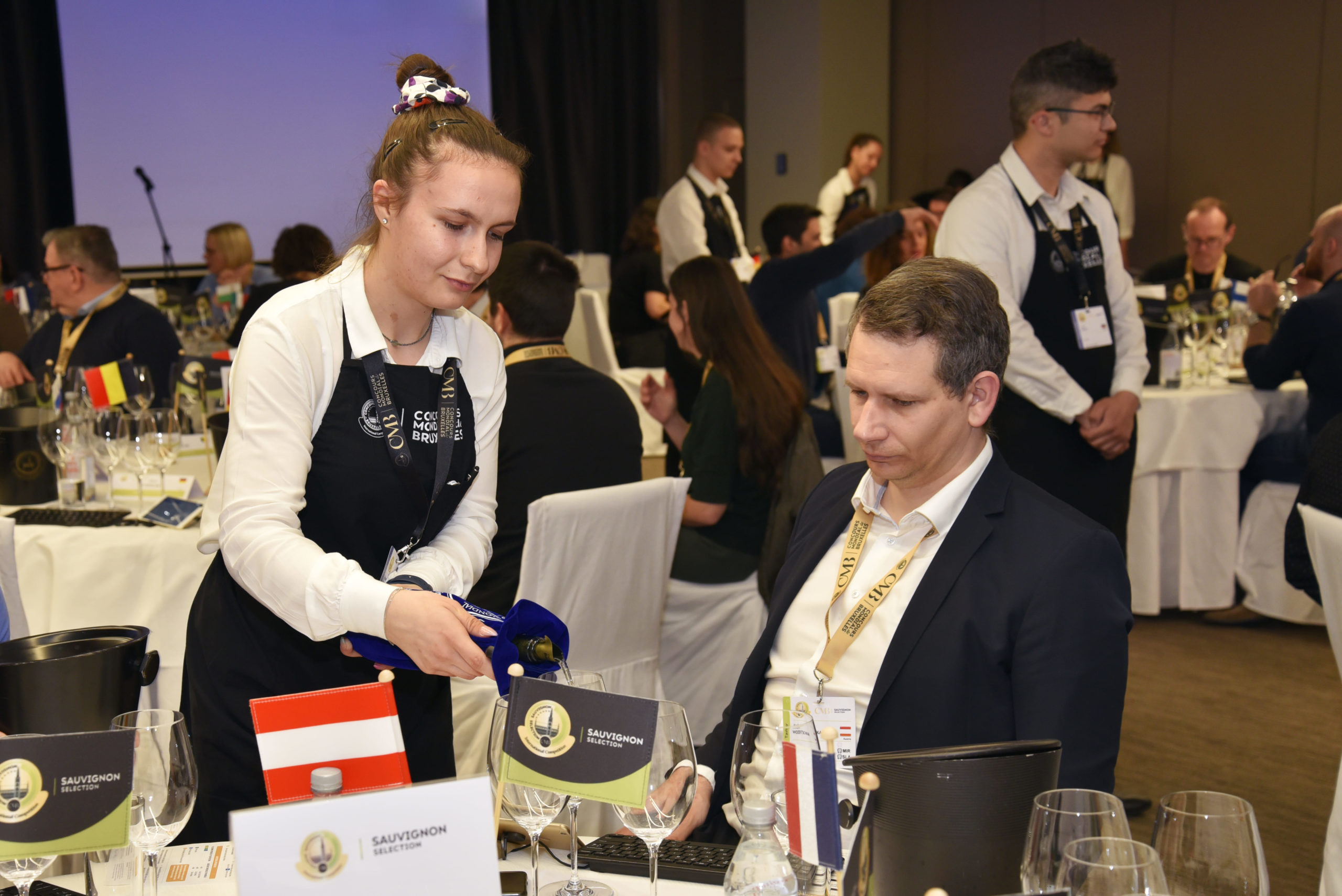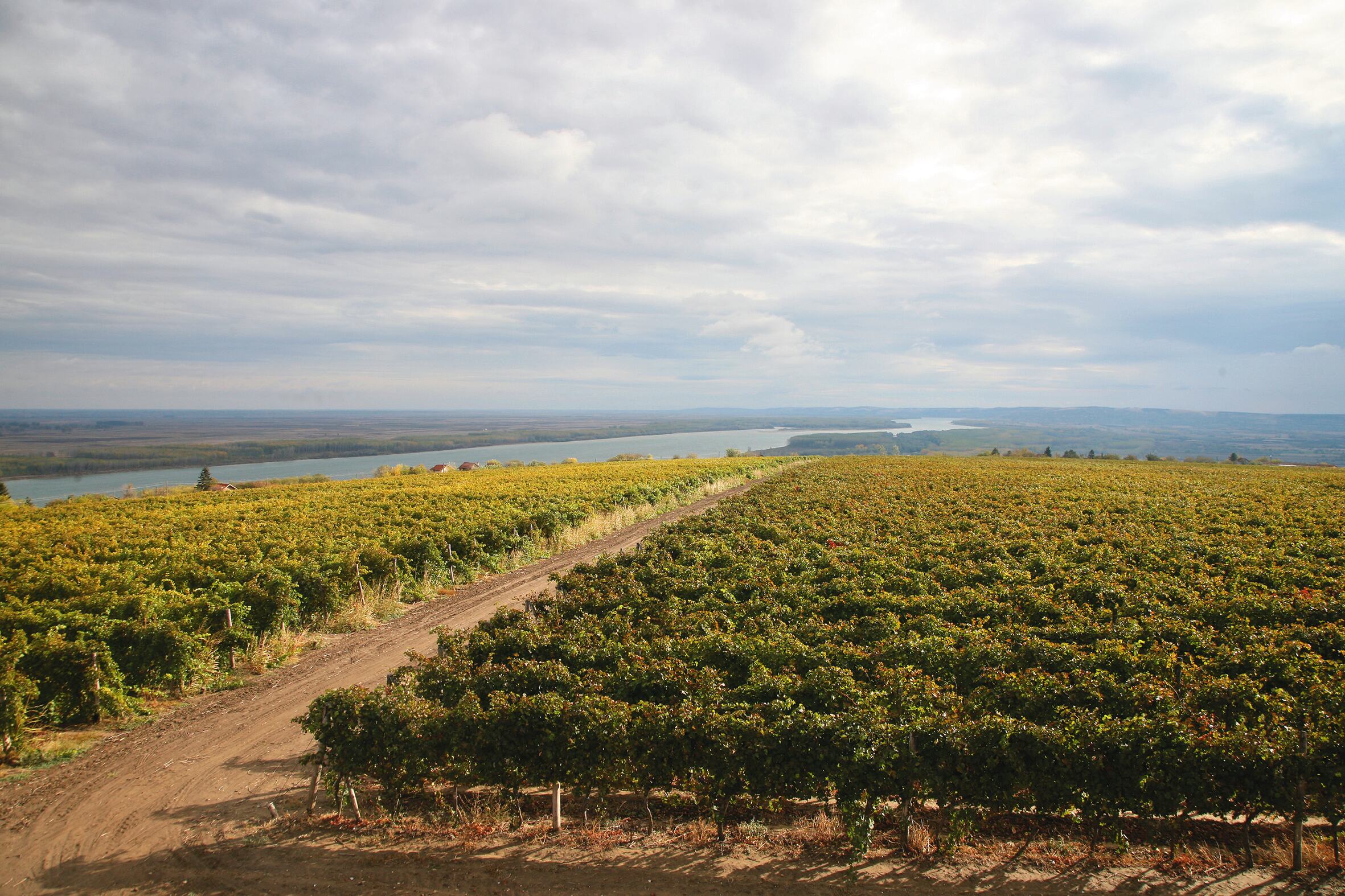California / Washington
California / Washington
The Sauvignon blanc grape first came to California in the second half of the 19th century. Charles Wetmore, the president and CEO of
the state’s viticultural commission, brought Sauvignon blanc and Sémillon cuttings from Château d’Yquem in Bordeaux to Livermore Valley in the late 1870s. Those cuttings became known as clone 1 and were first planted in Napa Valley at Inglenook winery in 1881 and eventually at Beaulieu whose Sauvignon blanc was awarded a gold medal at the 1915 International Wine Exposition held in San Francisco.
After the repeal of Prohibition in 1933, the variety was grown in Napa Valley for its high yields and used to produce a wine marketed as “Sauterne” or “Haut Sauterne,” a sweet, cloying jug wine, the better examples of which were made by Inglenook, Larkmead, Eschol (now Trefethen), and Robert Mondavi Winery. Dry Sauvignon blanc first gained recognition in Napa Valley when it was modelled after the wines of the Pouilly-Fumé region of the Loire Valley and marketed in 1968 by Mondavi as Fumé Blanc. Mondavi found success with Fumé Blanc and he didn’t seek to protect or copyright the name allowing the industry to freely adopt it.
In addition to Mondavi which makes “I Block” Fumé Blanc from vines planted in 1949 (believed to be the state’s oldest plantings), a handfulof well-known California producers label their Sauvignon blanc wines Fumé Blanc including Dry Creek Vineyards, Ferrari-Carano, Grgich Hills, Murphy Goode and J. Lohr. Typically the wines are lightly oaked but unoaked wines have also been labelled as Fumé Blanc.
Sauvignon blanc was introduced to Washington State in 1942. It was planted at Washington State University’s Irrigated Agriculture Research and Extension Center (IAREC) in Prosser in what is now the Yakima Valley AVA. The plant material was sourced from La Fata Brothers in St. Helena, Calif. and was, undoubtedly, clone 1. White wine production in Washington has historically focused on the cool-climate varieties of Riesling and Gewurztraminer; Sauvignon blanc acreage only began to increase over the last fifteen years from 287 ha (710 acres) in 2002 to 587 ha (1,451 acres) by 2017. The majority of Sauvignon Blanc plantings are found in the contiguous counties of Benton (1090 acres under vine), Klickitat (137), Yakima (100) and Franklin (76). Fumé Blanc labelling by Washington producers is now an artifact of the Mondavi era, and at last count there were only two wineries using that labelling term.
Regional Distribution
Over the last decade, plantings of Sauvignon Blanc in California have increased by 15 percent with Napa, Sonoma, and Lake Counties accounting for the majority of plantings followed by Monterey, Sacramento, San Joaquin, Mendocino and the Central Coast. In 2019, the variety was fourth in tons (120,521 T) crushed behind Chardonnay, French Colombard and Pinot Gris. Hectareage in California in 2019 stood at 6,371.
Over the last fifteen years, plantings in Washington State have doubled and the variety ranks fourth behind Riesling, Pinot Gris and Chardonnay with an area under vine of 587 hectares in 2019. The 2019 Sauvignon blanc crush came in at 8,740 T. In US States such as New York, Texas, Michigan and Virginia, there are diminutive plantings of Sauvignon blanc.
California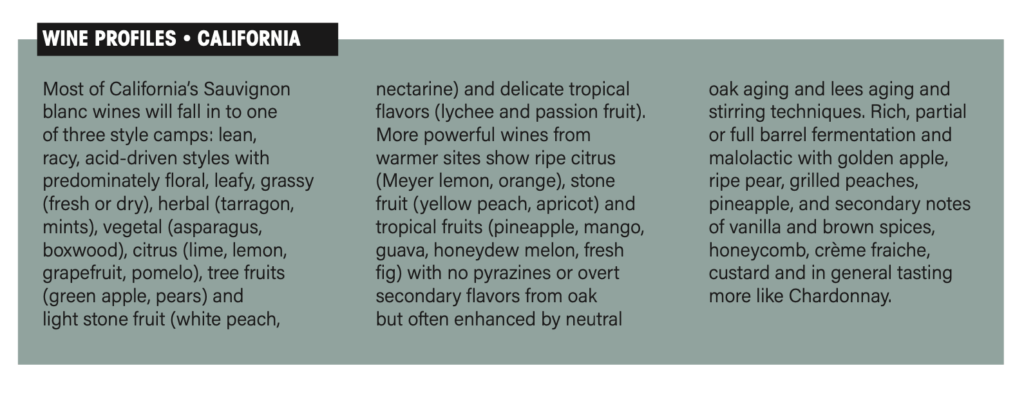
Napa County
Saint Helena and Calistoga, which are Napa Valley’s warmest AVAs, have older vine Sauvignon Blanc vineyards that produce outstanding examples of a variety often thought to be better suited to a cooler climate. Winemakers precisely time their picking decisions and make multiple passes during harvest to ensure the natural acidity and precursors necessary for medium-bodied, bright, aromatic styles showing ripe citrus, stone fruit and tropical fruit flavors. Vineyards in Rutherford and Oakville are typically planted closer to the Napa River on fluvial, gravelly loam soils that produce wines not unlike those found in Bordeaux (the origin of California’s clone 1) but with greater fruit intensity and significantly higher price tags.
Napa Valley producers have been successful with a segment dubbed “Super Sauvignons” for their flamboyant style often involving several different harvest passes in the vineyard, fermentation and aging in a variety of vessels including stainless steel barrels and tanks, concrete eggs, amphora, new and neutral barrels of acacia and oak, and winemaking practices like lees aging and stirring. Producers of triple-digit Napa Valley Cabernet-Sauvignon can easily command prices well in excess of $50 for their Sauvignon blanc wines. Mountain.
Sonoma County
There are around 1,100 hectares of Sauvignon blanc planted in Sonoma County and producers there – historically Geyser Peak Winery – often release their wines as early as January following harvest. The style is crisp and lively, with citrus flavors, a slight grassiness, medium to high acidity, and little or significant oak influence. Several of Sonoma’s sub AVAs are noted Sauvignon blanc terroirs. In warm Alexander Valley which is well known for ripening Bordeaux varieties on the mid slopes ofthe Mayacamas, Sauvignon blanc is at home in the gravelly soils. In the Dry Creek Valley AVA which is best known for Zinfandel, Dry Creek Vineyard and Winery’s DCV3 site is the original Sauvignon blanc planted in the Dry Creek Valley AVA. Russian River Valley may produce the most New Zealand-style Sauvignon blanc due to the maritime influence of the Petaluma Gap and the fractured sandstone and sandy loam Goldridge soil. Bennett Valley is more an alluvial bench than a valley. The volcanic history of the region produced Goulding-Toomes-Guenoc Association soils that include lava flow, tuff beds, sandstone, gravel and some conglomerate. Sauvignon blanc is planted in a frigid nook in the middle of the county. Sauvignon blanc is also grown in Sonoma Valley and on Sonoma Mountain.
Lake County
One of the state’s most relevant terroirs for Sauvignon blanc lies about one hour north of Napa County. The Lake County AVA and key sub-AVAs of Kelseyville Bench and High Valley grow a prodigious amount of the variety on red volcanic soils and colluvial benchlands in a high elevation, Mediterranean climate that is moderated by the largest freshwater lake in California. The combination of altitude and old vine vineyards many of which were planted in the 70s, 80s and 90s produce wines of intensity and quality showing a broad range of flavors from citrus, stone fruit, and tropical fruits like papaya and melon to fresh fig. Long Valley, another transverse valley that lies north of High Valley, has recently been planted to aromatic French clones by the region’s top grower.
Central Coast
Producers here are elevating the grape in a variety of styles, from brisk, grassy, mineral-driven versions that recall the Loire Valley to richer Sémillon-blends modeled after Bordeaux. Happy Canyon, the warmest AVA in Santa Barbara County, with its marine soils and high diurnal shift, has several sought-after producers who make wines that show grassy lime and key lime notes or ripe tropical fruits like melon and fig that are balanced with natural acidity and a mineral spine.
Washington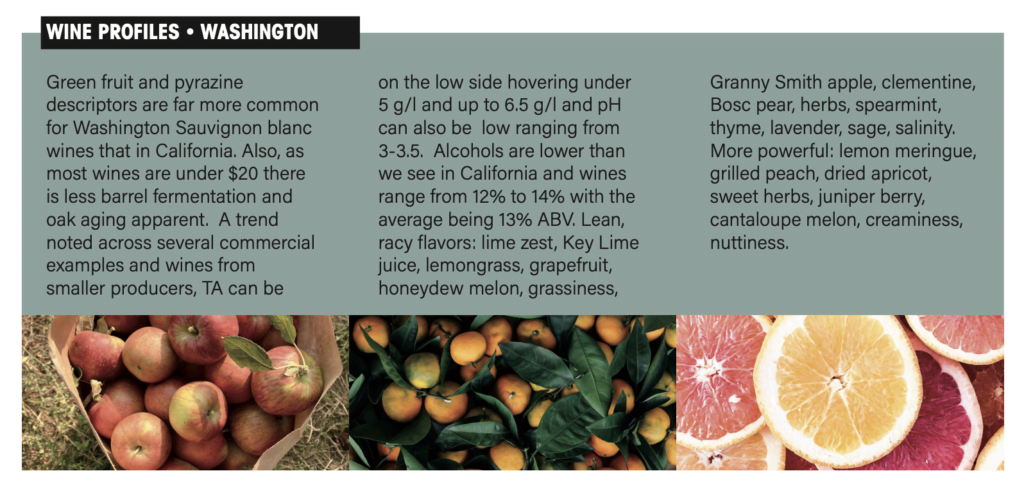
The large Columbia Valley
AVA and its sub AVAs most relevant for Sauvignon Blanc production include: the Yakima Valley, Wahluke Slope, Horse Heaven Hills, and the pending White Bluffs AVA which is home to the state’s oldest plantings of Sauvignon blanc at Sagemoor Farm. The Cascade Mountains to the west cast a rain shadow over the region which is a higher-elevation plateau with an arid continental climate, a marked diurnal shift and exceedingly low rainfall that averages 150 – 200 mm annually. Yakima Valley AVA grows more than one-third of all the vinifera wine grapes in the state and has a range of cooler to warmer meso climates with moderate to deep silt- loam soils layered over gravel or directly onto basalt bedrock. Horse Heaven Hills’ was first planted in 1972 and its proximity to the Columbia River creates 30% more wind and moderates temperature extremes reducing the risk from frost. Steep, south- facing slopes and well-drained soils of wind-blown sand and loess, Missoula Flood sediment, and hill slope rubble from the Columbia River basalt bedrock. Wahluke Slope has one of the driest, warmest climates in the state, allowing nearly complete control of vine vigor and ripening through irrigation. With uniform soils of deep, wind-blown sand and wind as a delimiting factor. Most vineyards here lie below 1,000 feet and have been planted within the last 15 years. The proposed White Bluffs AVA is a broad plateau that rises 200 feet above the surrounding landscape. The soils of loess and fine sand are thin allowing the vine roots to reach the high clay content Ringold Formation that retains water and reduces vine stress during dry conditions.
